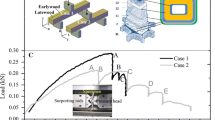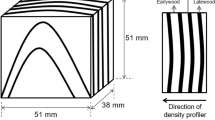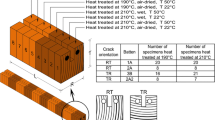Summary
The ultrastructural characteristics of fracture surfaces from southern pine and Douglas-fir specimens tested in tension at various angles to grain were examined. The fracture surace morphology was inspected using scanning electron microscopy. Three anatomical failure types were recognized: intercell failure, transwall failure, and intrawall failure. Certain failure characteristics were ascribed as a function of the magnitudes of paralleland perpendicular-tograin tension and parallel-to-grain shear present in the specimen. In specimens tested in paralleland perpendicular-to-grain tension, the thick-walled latewood cells were found to fail in a combination of transwall and intrawall failure. The intrawall failures were usually at the S1–S2 interface. The more thin-walled earlywood cells were more likely to exhibit abrupt, transwall failures. At intermediate angles of load to grain, surfaces indicative of the type found in pure shear tests were predominant. Perpendicularto-grain tension failures resulted in mostly intercell failures. Ray cells consistently exhibited transwall failures. The failure surface frequently changed planes in all loading modes. This path transfer was inevidably associated with material discontinuities in the wood. When the path did transfer, all three failure types were observed. No significant species effect was observed.
Similar content being viewed by others
References
Anthony, R. A. 1986. Experimental Verification of the Strength Prediction Model. M.S. Thesis, Colorado State University, Ft. Collins, Colorado
Atack, D.; May, W. D.; Morris, E. L.; Sproule, R. N. 1961. The energy of tensile and cleavage fracture of black spruce. TAPPI 44(8): 555–567
Bodig, J.; Jayne, B. A. 1982. Mechanics of Wood and Wood Composites. Van Nostrand Reinhold Co., New York, 712 pp
Clarke, S. H. 1935. Recent work on the relation between anatomical structure and mechanical strength in English ash. Forestry 9: 132
Côté, W. A.; Hanna, R. B. 1983. Ultrastructural characteristics of wood failure surfaces. Wood and Fiber Science 15(2): 135–163
DeBaise, G. R. 1972. Morphology of wood shear failure. J. Materials 7(4): 568–572
Dinwoodie, J. M. 1975. Timber — a review of the structural-mechanical property relationship. J. Microsc. 104(1): 3–32
Gibson, E. J. 1970. Some aspects of the relation between the structure of wood and its properties. Timberlab Papers No. 12, Forest Products Research Laboratory, Princes Risborough, Aylesbury, Bucks, 31 pp.
Grossman, P. U. S. 1978. The role of botanical structure of wood in the fracture process. Proceedings, Australian Fracture Group, Parkville, Victoria, Australia
Hankinson, R. L. 1921. Investigation of Crushing Strength of Spruce at Various Angles of Grain. Air Service Information Circular 3(259), Material Section Paper No. 130.
Ifju, G. 1964. Tensile strength behavior as a function of cellulose in wood. Forest Prod. J. 14(8): 366–372
Kloot, N. H. 1952. A micro-testing technique for wood. Aust. J. Appl. Sci. 3(2): 125–143
Kollmann, F. F. P. 1963. Phenomena of fracture in wood. Holzforschung 17(3): 65–71
Koran, Z. 1967. Electron microscopy of radial tracheid surfaces of black spruce separated by tensile failure at various temperatures. TAPPI 50(2): 60–67
Koran, Z. 1968. Electron microscopy of tangential tracheid surfaces of black spruce from tensile fracture at various temperatures. Svensk Papperstidn. 71(17): 567–575
Kucera, L. A.; Bariska, M. 1982. On the fracture morphology in wood. Wood Sci. Technol. 16: 241–259
Norris, C. B. 1950. Strength of orthotropic materials subjected to combined stresses. U.S. Forest Products Laboratory, Report No. 1816, Madison, Wisconsin, 19 pp.
Pellicane, P. J. 1980. Ultimate Tensile Strength Analysis of Wood. Ph.D. Dissertation, Colorado State University, Ft. Collins, Colorado
Pugel, A. D. 1986. Fracture Mechanics-based Failure Criterion for the Tensile Strength of Wood. Ph.D. Dissertation. Colorado State University, Ft. Collins, Colorado.
Robinson, W. 1920. The microscopical features of mechanical strains in timber and the bearing of these on the structure of the cell wall in plants. Philos. Trans. Soc. London, Series B, 210: 49–82
Author information
Authors and Affiliations
Rights and permissions
About this article
Cite this article
Zink, A.G., Pelikane, P.J. & Shuler, C.E. Ultrastructural analysis of softwood fracture surfaces. Wood Sci.Technol. 28, 329–338 (1994). https://doi.org/10.1007/BF00195280
Received:
Issue Date:
DOI: https://doi.org/10.1007/BF00195280




